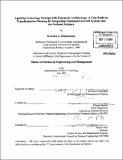| dc.contributor.advisor | Donna Rhodes. | en_US |
| dc.contributor.author | Richardson, Kristina L. (Kristina Lynn) | en_US |
| dc.contributor.other | System Design and Management Program. | en_US |
| dc.date.accessioned | 2010-09-13T14:08:34Z | |
| dc.date.available | 2010-09-13T14:08:34Z | |
| dc.date.issued | 2009 | en_US |
| dc.identifier.uri | http://hdl.handle.net/1721.1/58524 | |
| dc.description | Thesis (S.M.)--Massachusetts Institute of Technology, Engineering Systems Division, System Design and Management Program, 2009. | en_US |
| dc.description | "May 2009." Cataloged from PDF version of thesis. | en_US |
| dc.description | Includes bibliographical references (p. 96-103). | en_US |
| dc.description.abstract | The research presented in this thesis combines Enterprise Architecture and Technology Strategy for analyzing, evaluating, and recommending appropriate solutions for integrating Unmanned Aircraft Systems (UAS) into the National Airspace System (NAS). The thesis is organized into four sections. Section 1 introduces the strategic background, enterprise description, definitions of key terms, and the issues and interest surrounding UAS operations. Section 2 involves architecting the enterprise at its current state, which includes the vision, strategic objectives, enterprise layout, stakeholder analysis, and concludes with the architectural views of the current state. Section 3 discusses the vision and design for the future of the NAS enterprise, the current near-term efforts, the long-term preferred future state, and the transformation plan to achieve successful integration of UAS flight in the NAS. Finally, Section 4 concludes with the importance of leadership for success, final thoughts, recommendations, and future work. Technology Strategy coupled with Engineering Architecture emphasizes the development and application of ways of thinking that bring clarity to the complex co-evolution of technological innovation, the demand opportunity, systems architecture, business ecosystems, and decision-making and execution within the business. | en_US |
| dc.description.abstract | (cont.) Architecting the current state of the NAS enterprise and then applying the technology strategy framework in an incremental systems approach to fully understand the future state of the NAS involves figuring out how to create and capture value, anticipating and deciding how to respond to the behavior of customers, complimentors and competitors, and develop and deliver technologies, platforms, and products. | en_US |
| dc.description.statementofresponsibility | by Kristina L. Richardson. | en_US |
| dc.format.extent | 114 p. | en_US |
| dc.language.iso | eng | en_US |
| dc.publisher | Massachusetts Institute of Technology | en_US |
| dc.rights | M.I.T. theses are protected by
copyright. They may be viewed from this source for any purpose, but
reproduction or distribution in any format is prohibited without written
permission. See provided URL for inquiries about permission. | en_US |
| dc.rights.uri | http://dspace.mit.edu/handle/1721.1/7582 | en_US |
| dc.subject | Engineering Systems Division. | en_US |
| dc.subject | System Design and Management Program. | en_US |
| dc.title | Applying technology strategy with enterprise architecting : a case study in transformation planning for integrating Unmanned Aircraft Systems into the National Airspace | en_US |
| dc.title.alternative | Case study in transformation planning for integrating Unmanned Aircraft Systems into the National Airspace | en_US |
| dc.type | Thesis | en_US |
| dc.description.degree | S.M. | en_US |
| dc.contributor.department | System Design and Management Program. | en_US |
| dc.contributor.department | Massachusetts Institute of Technology. Engineering Systems Division | |
| dc.identifier.oclc | 630133655 | en_US |
